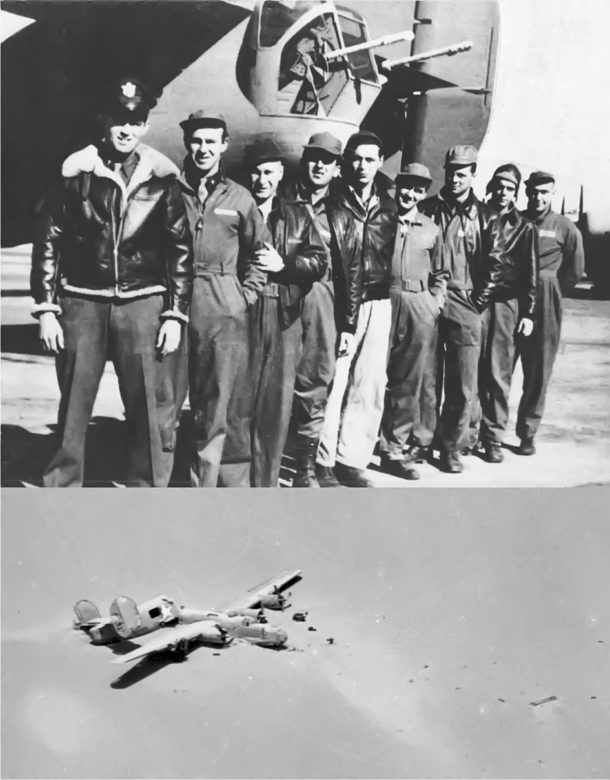
Seventy-three years ago this month, a USAAF/Consolidated B-24D Liberator and her crew vanished upon return from their first bombing mission over Italy. Known as the Lady Be Good, the hulk of the ill-fated aircraft was found sixteen years later lying deep in the Libyan desert more than 400 miles south of Benghazi.
The disappearance of the Lady Be Good and her young air crew is one of the most intriguing and haunting stories in the annals of aviation. Books and web sites abound which report what is now known about that doomed mission. Our purpose here is to briefly recount the Lady Be Good story.
The B-24D Liberator nicknamed Lady Be Good (S/N 41-24301) and her crew were assigned to the USAAF’s 376th Bomb Group, 9th Air Force operating out of North Africa. Plane and crew departed Soluch Army Air Field, Libya late in the afternoon of Sunday, 04 April 1943. The target was Naples, Italy some 700 miles distant.
Listed from left to right as they appear in the photo above, the crew who flew the Lady Be Good on the Naples raid were the following air force personnel:
1st Lt. William J. Hatton, pilot — Whitestone, New York
2nd Lt. Robert F. Toner, co-pilot — North Attleborough, Massachusetts
2nd Lt. D.P. Hays, navigator — Lee’s Summit, Missouri
2nd Lt. John S. Woravka, bombardier — Cleveland, Ohio
T/Sgt. Harold J. Ripslinger, flight engineer — Saginaw, Michigan
T/Sgt. Robert E. LaMotte, radio operator — Lake Linden, Michigan
S/Sgt. Guy E. Shelley, gunner — New Cumberland, Pennsylvania
S/Sgt. Vernon L. Moore, gunner — New Boston, Ohio
S/Sgt. Samuel E. Adams, gunner — Eureka, Illinois
The LBG was part of the second wave of twenty-five B-24 bombers assigned to the Naples raid. Things went sour right from the start as the aircraft took-off in a blinding sandstorm and became separated from the main bomber formation. Left with little recourse, the LBG flew alone to the target.
The Naples raid was less than successful and like most of the other aircraft that did make it to Italy, the LBG ultimately jettisoned her unused bomb load into the Mediterranean. The return flight to Libya was at night with no moon. All aircraft recovered safely with the exception of the Lady Be Good.
It appears that the LBG flew along the correct return heading back towards their Soluch air base. However, the crew failed to recognize when they were over the air field and continued deep into the Libyan desert for about 2 hours. Running low on fuel, pilot Hatton ordered his crew to jump into the dark night.
Thinking that they were still over water, the crewmen were surprised when they landed in sandy desert terrain. All survived the harrowing experience with the exception of bombardier Woravka who died on impact when his parachute failed. Amazingly, the LBG glided to a wings level landing 16 miles from the bailout point.
What happens next is a tale of tragic, but heroic proportions. Thinking that they were not far from Soluch, the eight surviving crewmen attempted to walk out of the desert. In actuality, they were more than 400 miles from Soluch with some of the most forbidding desert on the face of the earth between them and home. They never made it back.
The fate of the LBG and her crew would be an unsolved mystery until British oilmen conducting an aerial recon discovered the aircraft resting in the sandy waste on Sunday, 09 November 1958. However, it wasn’t until Tuesday, 26 May 1959 that USAF personnel visited the crash site. The aircraft, equipment, and crew personal effects were found to be remarkably well-preserved.
The saga about locating the remains of the LBG crew is incredible in its own right. Suffice it to say here that the remains of eight of the LBG crew members were recovered by late 1960. Subsequently, they were respectfully laid to rest with full military honors back in the United States. Despite herculean efforts, the body of Vernon Moore has never been found.
A pair of LBG crew members kept personal diaries about their ordeal in the Libyan desert; co-pilot Toner and flight engineer Ripslinger. These diaries make for sober reading as they poignantly document the slow and tortuous death of the LBG crew. To say that they endured appalling conditions is an understatement. The information the diaries contain suggests that all of the crewmen were dead by Tuesday, 13 April 1943.
Although they did not made it out of the desert, the LBG crewmen far exceeded the limits of human endurance as it was understood in the 1940’s. Five of the crew members traveled 78 miles from the parachute landing point before they succumbed to the ravages of heat, cold, dehydration, and starvation. Their remains were found together.
Desperate to secure help for their companions, Moore, Ripslinger and Shelley left the five at the point where they could no longer travel. Incredibly, Ripslinger’s remains were found 26 miles further on. Even more astounding, Shelley’s remains were discovered 37.5 miles from the group. Thus, the total distance that he walked was 115.5 miles from his parachute landing point in the desert.
We honor forever the memory of the Lady Be Good and her valiant crew. However, we humbly note that theirs is but one of the many cruel and ironic tragedies of war. To the LBG crew and the many other souls whose stories will never be told, may God grant them all eternal rest.

